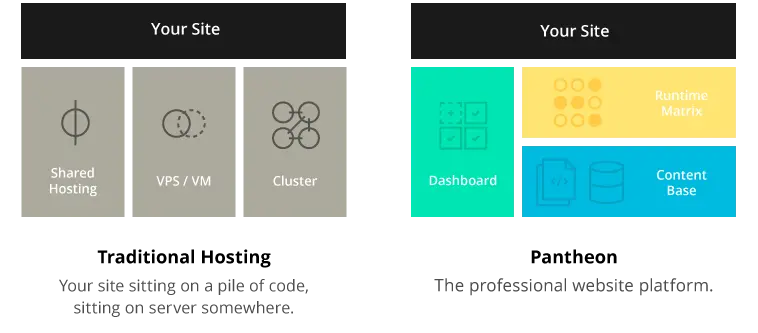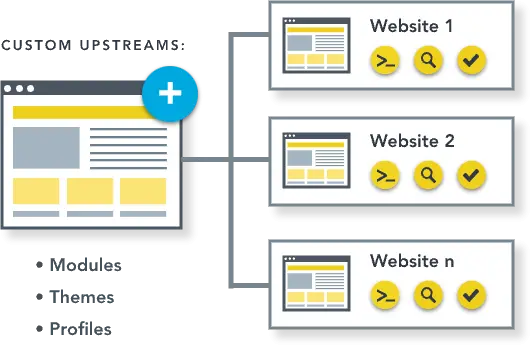The Modern Alternative to Drupal Multisite
Image

If you’ve ever managed more than one Drupal site, you’ve probably run into the term “Drupal multisite.” On paper, it sounds perfect: run multiple sites from a single codebase, update everything at once and save time. That idea made sense back in 2008, when websites were smaller and expectations were lower.
Fast forward to now, and things look very different. Today, sites need stronger security, clear compliance boundaries and the ability to scale independently. Drupal multisite struggles in this modern reality. A single broken update or hacked module can ripple across every site in the network. Instead of saving time, teams often get stuck in update paralysis and spend more energy trying to keep sites safe.
But don’t worry – in this post, we’ll uncover what Drupal multisite actually does and why it breaks for today’s needs. We’re also going to introduce you to a much better solution that replaces multisite for the better: Pantheon Upstreams.
What Drupal multisite actually does – and why that's now a problem
Drupal multisite is a way to run multiple websites from a single Drupal codebase. Each site has its own database and files, but they all share the same modules, themes and core. In practice, this means you can spin up new sites quickly and update them all at once by changing the shared code.
When Drupal 6 and 7 were popular, this was an amazing solution. Organizations like universities, governments and publishers wanted to launch dozens of microsites without hiring dozens of separate teams. Servers were expensive and “cloud hosting” wasn’t mature yet. Multisite gave them speed and cost savings.
But the web nowadays is not the web of 2008. Every site today is a digital product – with unique integrations, security needs and traffic patterns. Sharing one codebase across 20, 50 or 100 sites means:
- A single bad update can break everything.
- One site’s traffic spike can slow down the others.
- Security vulnerabilities spread instantly across all sites.
- Developers can’t safely customize individual sites without risking conflicts.
This is what we call the “blast radius” problem: the bigger your multisite network, the bigger the damage when something goes wrong.
The security nightmare that makes developers abandon multisite
In theory, multisite makes updates simple. Update once and every site is patched. In reality, teams often get stuck. Why? Because if an update breaks just one site, it threatens the entire fleet. Developers delay patches, test endlessly or avoid updates altogether. Meanwhile, security holes stay open.
Modern platforms like Pantheon flip this model. Each site runs in its own containerized environment with its own code, database and files. Updates can be applied one site at a time, tested safely and rolled out on your schedule. If one site fails, the others stay online.
There is also the compliance nightmare for regulated industries like finance, healthcare and higher ed. Shared codebases blur compliance boundaries. If one site stores sensitive data or requires special logging, it’s almost impossible to separate that from the rest of the network. Auditors don’t like “shared everything.” They want clear isolation.
With Pantheon’s model, every site has independent audit logs, clear security boundaries and granular access control – a must for compliance in this day and age.
Modern alternatives: How Upsun, Acquia and Pantheon replaced multisite
Over the last decade, major Drupal hosting providers realized that traditional multisite doesn’t fit today’s needs. Instead, they built models that give you central control without forcing all your sites to share the same fragile codebase.
Upsun (formerly Platform.sh)
Upsun is popular with engineering-heavy teams because of its environment cloning model. Every project can have multiple environments – production, staging, development – that you can spin up instantly. This makes testing updates very safe: you can clone your live site, apply changes and merge them back only when they’re proven to work.
Each environment runs as a cluster of isolated containers, leveraging Upsun's excellent cloning and containerization to provide dedicated resources for code, databases, and services. In multi-application projects, several apps can coexist within a single project while maintaining container-level isolation. However, while powerful, this primary multi-app model often requires a developer to manage a single massive, complex monorepo with all applications nested inside.
For organizations with many sites, Upsun recommends creating separate projects for each one to avoid the complexity of a single large monorepo.
Acquia
Acquia tackled the multisite problem with Site Factory – a management layer designed for large enterprises. It offers:
- A central control panel for spinning up new Drupal sites.
- Pre-approved site templates that enforce brand and compliance standards.
- Governance tools for large organizations with many stakeholders.
For organizations like governments or universities, this “factory” approach is appealing: marketing teams can launch new sites on their own, while IT still enforces standards. However, the same enterprise-grade governance and Drupal-specific tooling that make Site Factory powerful can also make it heavier and costlier than smaller teams really need.
Pantheon
Pantheon took a different path. Instead of offering a new twist on multisite, Pantheon made a deliberate decision not to support multisite at all.
Instead, Pantheon introduced Upstreams – a Git-based distribution model that offers:
- Efficiency: A single upstream repository holds your base Drupal code, modules and themes.
- Isolation: Each site gets its own Git repo, containerized infrastructure, database and files.
- Flexibility: Sites can take updates from the upstream, but also add their own customizations safely.
This means updates flow downstream from the upstream repo, but never sideways across sites. If one site breaks, the others stay safe. If one site needs a custom integration, it won’t interfere with the rest.
For a deeper comparison, see our posts on Pantheon vs. Upsun and Pantheon vs. Acquia.
Setting up multisite on Pantheon? Why you can’t – and why that’s good
As we’ve just outlined, Pantheon deliberately does not support Drupal multisite. This isn’t a missing feature – it’s an architectural decision.
Pantheon was built to prevent the cascade failures that plague traditional multisite setups. Instead of one fragile codebase powering dozens of sites, Pantheon isolates each site in its own container, database and file system.
Image

This isolation protects you from downtime, security breaches and compliance headaches.
So, instead of multisite, Pantheon gives you Upstreams – a safer, more flexible alternative. This is all it takes:
- Create an Upstream repository with your standard Drupal installation, modules and themes.
- When you need a new site, create it from the Upstream. Each new site starts with the same baseline.
- Each site gets its own Git repository that tracks the Upstream but can also accept local customizations.
Image

This approach lets you roll out shared updates while keeping each site independent.
When Drupal multisite makes sense vs. when it’s technical debt
Drupal multisite isn’t always wrong. In very narrow, low-risk circumstances, it can still deliver value.
For example, if you’re running a handful of nearly identical microsites on self-hosted infrastructure – little to no customization, predictable low traffic and tolerance for shared downtime – the single codebase can reduce overhead and be perfectly adequate.
Outside those edges, multisite tends to accumulate technical debt. As soon as sites diverge – different integrations, payment gateways, content models or themes – the shared codebase becomes a liability. One flawed update or vulnerability magnifies across the portfolio, slowing releases and increasing the chance of an outage that hits every site at once. Nowadays, with stricter compliance expectations and always-on experiences, that risk is hard to justify.
Here are several real-world scenarios and recommendations:
- Universities: Department websites often need a common foundation, but also unique branding and content types. Use Pantheon Upstreams for central control while giving departments flexibility.
- Franchises: Each location may need unique offers, integrations or payment gateways. Isolation is critical – avoid multisite.
- Campaign microsites: If they’re truly identical and temporary, multisite or even the Domain Access module might work, but only for very small, low-risk projects.
- Agencies: Running client sites on multisite is a disaster waiting to happen. One client’s traffic spike or vulnerability should never impact another’s.
Automating multisite governance across departments and teams
In large organizations, “governance” usually means endless meetings, policy docs and compliance checklists. But on Pantheon, governance becomes built into the platform. With Upstreams, every new site starts with pre-approved modules, themes and security settings. You don’t have to remind teams to follow standards – the platform enforces them automatically.
Governance as code
Instead of relying on trust, governance flows programmatically:
- Role-based access control (RBAC) manages who can push changes to test, staging or production.
- Automated testing pipelines catch broken code before it’s deployed.
- Centralized billing and cost allocation keep budgets transparent.
- Every change is tracked through Audit logs, satisfying compliance and reducing finger-pointing.
This shifts governance from documents on a wiki to rules enforced in code.
The human side of governance
The best governance is the kind people actually want to follow. With Pantheon, departments feel empowered. Instead of waiting weeks for IT to provision a new site, they can launch a fully branded, compliant site in minutes. Standards stop being obstacles and start being accelerators.
Your path forward from multisite anxiety to WebOps confidence
For a long time, Drupal multisite management felt like the only answer for running many sites. But today, it creates more problems than it solves. A single codebase means bigger blast radii, stalled updates and compliance risks that modern teams can’t afford.
Pantheon solves this differently. With Upstreams and isolated containers, each site stays independent – its own code, database and scaling – while still pulling updates from a shared base. You get the speed and consistency of multisite, but without the fragility. Plus, governance happens automatically through role-based access, audit logs and controlled update flows.
Ready to leave multisite headaches behind? Get started with Pantheon today and use Upstreams to manage multiple Drupal sites at scale with speed, safety and control.